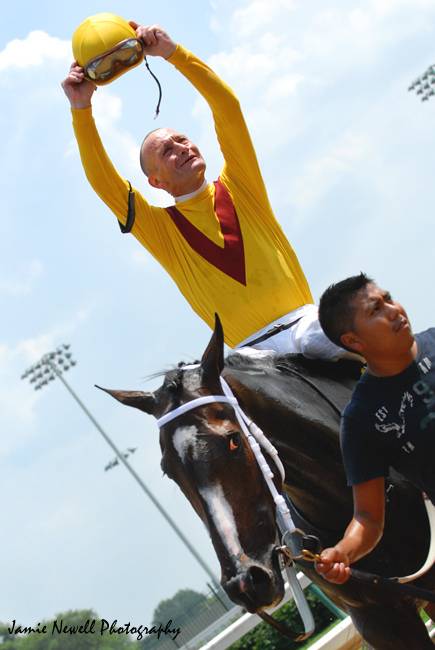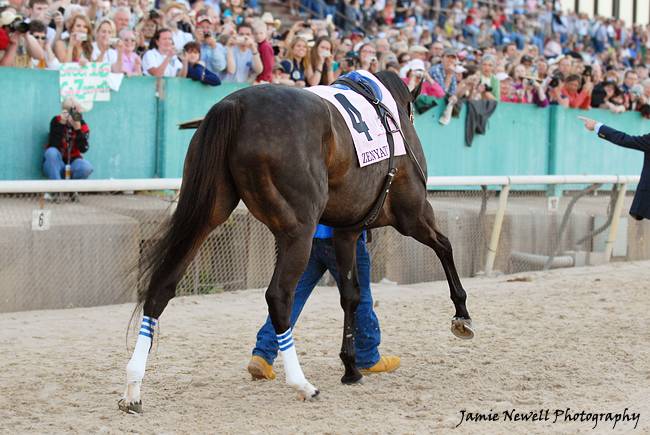 The anticipation hung over Churchill Downs in the same way the balmy afternoon heat clung to my skin and made it hard to breathe. We had all come to see one thing, and within two minutes, the question that lingered over all our lips would be answered. As I looked up at the JumboTron and saw Rachel Alexandra take the lead in the middle of the final turn with no urging by Calvin Borel, that familiar feeling came back—that mixed sensation of excitement and confidence that affirms you’re about to witness something special. In the last year, that feeling has been coined as “Rachelesque.” Though she was only facing a paltry field of competitors, a palpable change rose in the shadow of the twin spires—a turning point that signaled the Horse of the Year was back in form. A roar arose from the grandstands, a sound like the ocean about to hurl a tidal wave in your general direction. As she began to draw clear and that sound of thousands of voices heralding their queen surged, it took everything in my power to refrain from jumping up and down on my ladder on the inside rail and screaming in victory as the filly began to pull away to a 10-length lead. The Horse of the Year was returning to her former glory in just the way she needed. It didn’t matter who she was facing. It didn’t matter it took her two losses to reach this point. All that counted was that she had turned back her demons and that Rachel was Rachelesque once again. She crossed the wire to an eruption of celebration. You’d have thought, if you didn’t know any better, that a life had been on the line for all the yelling and shouting. In many ways, it was.
The anticipation hung over Churchill Downs in the same way the balmy afternoon heat clung to my skin and made it hard to breathe. We had all come to see one thing, and within two minutes, the question that lingered over all our lips would be answered. As I looked up at the JumboTron and saw Rachel Alexandra take the lead in the middle of the final turn with no urging by Calvin Borel, that familiar feeling came back—that mixed sensation of excitement and confidence that affirms you’re about to witness something special. In the last year, that feeling has been coined as “Rachelesque.” Though she was only facing a paltry field of competitors, a palpable change rose in the shadow of the twin spires—a turning point that signaled the Horse of the Year was back in form. A roar arose from the grandstands, a sound like the ocean about to hurl a tidal wave in your general direction. As she began to draw clear and that sound of thousands of voices heralding their queen surged, it took everything in my power to refrain from jumping up and down on my ladder on the inside rail and screaming in victory as the filly began to pull away to a 10-length lead. The Horse of the Year was returning to her former glory in just the way she needed. It didn’t matter who she was facing. It didn’t matter it took her two losses to reach this point. All that counted was that she had turned back her demons and that Rachel was Rachelesque once again. She crossed the wire to an eruption of celebration. You’d have thought, if you didn’t know any better, that a life had been on the line for all the yelling and shouting. In many ways, it was.
Rachel Alexandra’s victory in the Grade II Fleur de Lis was more than just visually impressive; it was a victory by the numbers, as well. Her Beyer Speed Figure for the race was calculated to a 108—the same number she earned in her smashing victory in the Grade I Kentucky Oaks at the same track, when she was at the apex of breaking out into her amazing season last year. In comparison, Blame won the Grade I Stephen Foster hours after the Fleur de Lis with a Beyer of 102, and at the same distance of 1 1/8-miles, Blame ran a full second slower than Rachel’s time of 1:48.78. What’s more, Rachel was carrying 124 pounds, while Blame was carrying 120 pounds; while Rachel ran to a 10 ½-length victory without much more than a shake of the reins, Blame was strongly encouraged by Garrett Gomez until he was able to put away speedball Battle Plan, winning by ¾ of a length. Had she run in the Stephen Foster, Rachel would’ve been carrying 118 pounds and could’ve conceivable beaten some of the most talented males in the handicap division. She ran the fastest 1 1/8-mile of the spring meet at Churchill Downs this year. When I met Rachel Alexandra at the winner’s circle, I overheard Calvin proclaim, “She’s back, baby.” Indeed; the Horse of the Year has returned. And all is now right in our little world of racing.
The following day, the undefeated Breeders’ Cup champion Zenyatta met her most testing challenge to date. But instead of finding this challenger on the dirt or in a race against males, she found it on her own home turf at Hollwood Park, in a race she had won twice before—the Vanity Handicap for fillies and mares. In her patented running style, Zenyatta came from dead last to make her bid into the record books, putting her unblemished record on the line to try to beat the immortal Citation and Cigar by winning 17 races in a row.* As jockey Mike Smith decided to take the outside trip, circling the field six-wide turning for home, it appeared as if he’d cost her the race. Late-running stakes winner St. Trinians had by that time grabbed the chance to fire a furious charge ahead of the champion, and with her eggbeater stride, was gobbling up ground in the desperate final seconds. Once straightened away into the stretch, Zenyatta was summoned to uncoil her gigantic stride, and she did so slowly, chugging like a steam engine building momentum, sensing the urgency of the situation. At the 16th pole, St. Trinians was a length and a half in front and going away from the rest of the horses while Zenyatta ebbed closer and closer. The track announcer’s voice rose an octave. The fans became frantic. It appeared there was no way the California Colossus was going to get up in time. For a dire moment, St. Trinians eyeballed that big dark shadow on her right and valiantly struggled to maintain her lead. But the locomotive was in full-flight and firing on all cylinders, and somehow passed her by half a length on the wire. Remaining undefeated in 17 lifetime starts, Zenyatta stamped herself as the new benchmark for which all others would be measured.
 Make no mistake; though Zenyatta won by considerably less of a margin than Rachel Alexandra, it’s hard to believe any horse could’ve won that race under the same conditions. Appearing soundly defeated at the 16th pole, Zenyatta reached into reserves few horses can ever hope to have turning toward home. Overcoming a wide trip, her last-to-first running style, a handicap of 129 pounds, and a foe as noble-hearted as they come, Zenyatta won her third Vanity Handicap as spectacularly as any horse that weekend. Time and time again, Zenyatta has proven her talent trumps her situations, even when it seems she has no chance. Had she been entered in the Grade I Stephen Foster, there is hardly a question as to whether or not she would’ve blown the boys out of the park.
Make no mistake; though Zenyatta won by considerably less of a margin than Rachel Alexandra, it’s hard to believe any horse could’ve won that race under the same conditions. Appearing soundly defeated at the 16th pole, Zenyatta reached into reserves few horses can ever hope to have turning toward home. Overcoming a wide trip, her last-to-first running style, a handicap of 129 pounds, and a foe as noble-hearted as they come, Zenyatta won her third Vanity Handicap as spectacularly as any horse that weekend. Time and time again, Zenyatta has proven her talent trumps her situations, even when it seems she has no chance. Had she been entered in the Grade I Stephen Foster, there is hardly a question as to whether or not she would’ve blown the boys out of the park.
With Zenyatta remaining at the top of her game, and now Rachel Alexandra coming back to her best form, what will this summer bring us? Though the connections of the Horse of the Year plan each race on a day-to-day basis, waiting until the last possible moment to commit to a race, Zenyatta’s plans have, unfortunately, been rerouted to the tired and true path of the past two years, where she stayed in the California circuit and defeated the same fillies and mares each time out until the Breeders’ Cup. With the Breeders’ Cup Classic at Churchill being the ultimate goal of both of these champions in early November, it only makes sense that they would want to test the conditions in a similar race. Zenyatta has never faced males on dirt before, though her performances over Oaklawn’s natural surface prove she can more than handle the switch from the synthetics. If she wanted to run a real warm-up to the Breeders’ Cup, Zenyatta could run at Saratoga or Belmont in the Whitney, the Woodward, or the Jockey Club Gold Cup. It seems this itinerary is the stuff of dreams, however, as she’d have to “ship across mountains,” or so her connections lament. As for Rachel, her connections might want to build her up slower than last year to keep her pinnacle of fitness targeted around November 6th. Though that same list of races could serve to point her versus some proven males, it’s more likely she will next run in a female handicap, like the Ruffian on August 1st. But if Zenyatta stays at home, she will be dogged by her new rival, St. Trinians, as her trainer has already made plans to point his mare toward the Grade I Clement Hirsch at Del Mar.
Whichever road these two champions take to the Breeders’ Cup, it will be an exciting one. And for as much as we’ve had to look forward to in the 3-year-old division, the older handicap division will serve as the more thrilling of the two this year. It’s not often we are allowed the privilege to root for our champions after their 3-year-old season, so even as we grumble and mumble about Rachel and Zenyatta not facing Quality Road or Blame before November, the fact that we have them at all is something worth celebrating. It’s a consolation I’ll happily take in order to witness greatness.
*The current North American record of consecutive wins is held by Peppers Pride, who won 19 of 19 races, but these races were all restricted to New Mexico state-breds.








